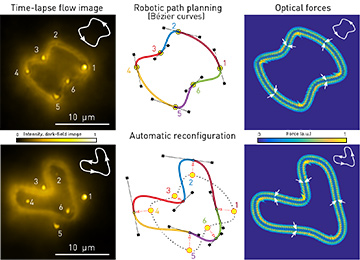 Plasmonic nanoparticles (100-nm-diameter gold spheres) are optically transported along reconfigurable trajectories, following robotic motion planning based on Bézier curves, in paths designed to impact on six target objects (top) or avoid them (bottom). The left-hand column shows time-lapse dark-field microscope images of the generated nanoparticle flows (see video online); the middle column schematically represents the trajectory design; and the right-hand column displays the calculated optical forces exerted on the particles.
Plasmonic nanoparticles (100-nm-diameter gold spheres) are optically transported along reconfigurable trajectories, following robotic motion planning based on Bézier curves, in paths designed to impact on six target objects (top) or avoid them (bottom). The left-hand column shows time-lapse dark-field microscope images of the generated nanoparticle flows (see video online); the middle column schematically represents the trajectory design; and the right-hand column displays the calculated optical forces exerted on the particles.
Optical tweezers, which use strongly focused laser beams to manipulate small particles, have revolutionized our understanding of the microworld, providing techniques for cell and single-molecule studies, for microfabrication, and more.1 However, most efforts have focused on manipulating individual micro-objects, or a few of them, generally ignoring the problem of optical transportation of particles en masse. Previous researchers have demonstrated simultaneous transport of several particles along linear and circular-like trajectories by exploiting suitable beams such as optical vortices or combinations of beams.2
Using a totally different approach and a beam specifically designed for the application in question, we have developed a holographic optical manipulation tool that allows for massive light-driven transport of metallic and dielectric micro- and nanoparticles.3 This freestyle optical trap4 is created with a polymorphic laser beam—described by a surprisingly simple closed-form expression5—that is strongly focused in the form of an arbitrary light curve (defining the particle trajectory), with an independently prescribed phase gradient along it.
The trap makes it possible to exploit the optical forces arising from the beam’s intensity and phase gradients for particle confinement and propulsion along the required trajectory.3–5 The light curve’s shape and size are independent of the propelling force, which can be non-uniform if the particles need to be sped up or slowed down at points along their trajectories.4,5 A freestyle trap can even be redesigned in real time, enabling fast automatic reconfiguration of particle trajectory and speed—similar to robotic motion planning—to avoid contact with, or to impact on, objects in the host environment.
We have demonstrated these functionalities experimentally on metallic plasmonic nanoparticles, even using a resonant laser wavelength to provide both optical transport and heating of the particles simultaneously—a capability of special interest for targeted drug delivery, micro-scale photothermal therapy and nanolithography.3 We envision that this laser tool will expand horizons in optical manipulation, light–material processing and other applications yet to be explored.
Researchers
José A. Rodrigo and Tatiana Alieva, Universidad Complutense de Madrid, Spain
References
1. D.G. Grier. Nature 424, 810 (2003).
2. Y. Roichman et al. Phys. Rev. Lett. 100, 013602 (2008).
3. J.A. Rodrigo and T. Alieva. Sci. Rep. 6, 33729 (2016).
4. J.A. Rodrigo and T. Alieva. Optica 2, 812 (2015).
5. J.A. Rodrigo and T. Alieva. Sci. Rep. 6, 35341 (2016).
